Key takeaways:
- Test documentation is crucial for effective communication and project consistency, reducing confusion and boosting team efficiency.
- Key components such as test cases, test plans, and defect logs aid in maintaining clarity and collaboration among team members.
- Utilizing appropriate tools for test management enhances organization and improves collaboration, especially in remote teams.
- Regular feedback and dynamic documentation practices can significantly improve the relevance and effectiveness of test documentation.
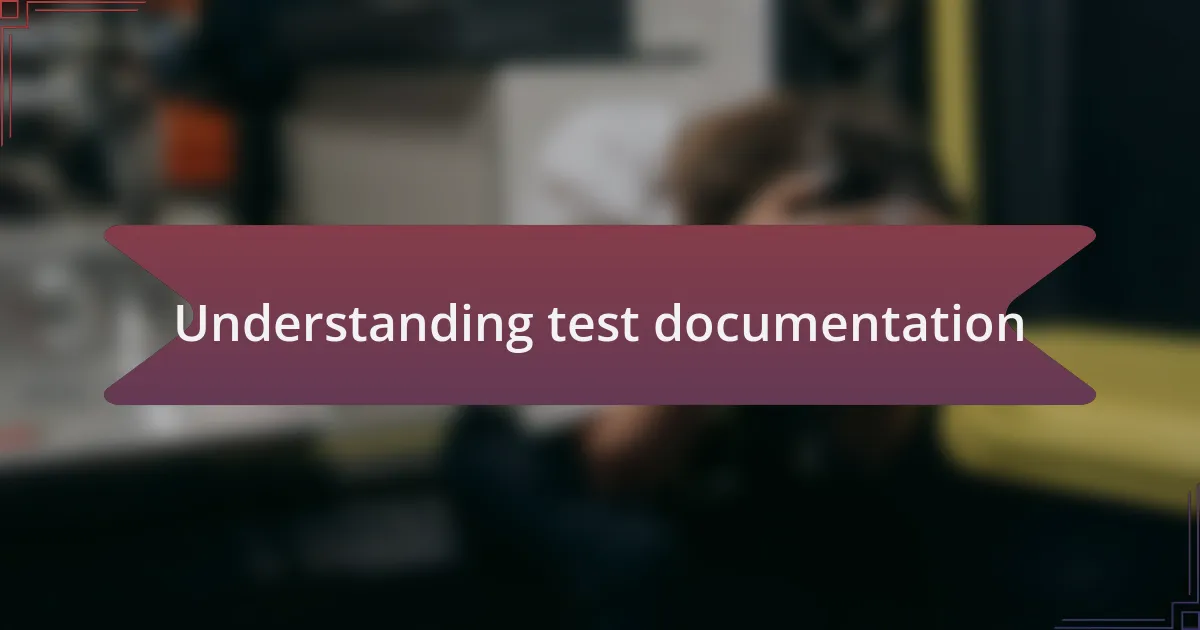
Understanding test documentation
Understanding test documentation is essential for any software development project. I’ve often found that when teams underestimate the importance of documenting their tests, they encounter significant challenges later on. For example, there was a time when I joined a project in its later stages and found no clear documentation. It felt like stepping into a labyrinth with no map. How could I understand what was tested and what wasn’t?
At its core, test documentation serves as a communication tool within a development team. It ensures everyone is on the same page about what to expect from the software and clarifies the testing process. I remember when our team transitioned to a more structured approach to documentation— the reduction in confusion and the boost in efficiency was palpable. The clarity paved the way for smoother sprints and more productive discussions.
Moreover, well-maintained test documentation acts as a historical record, which is invaluable for future projects. Reflecting on my experience, I’ve seen how revisiting past documents not only sparks ideas but also helps avoid repeating mistakes. Have you ever wondered how some projects seem to run seamlessly while others struggle? Often, it comes down to how well the documentation supports the team’s efforts.
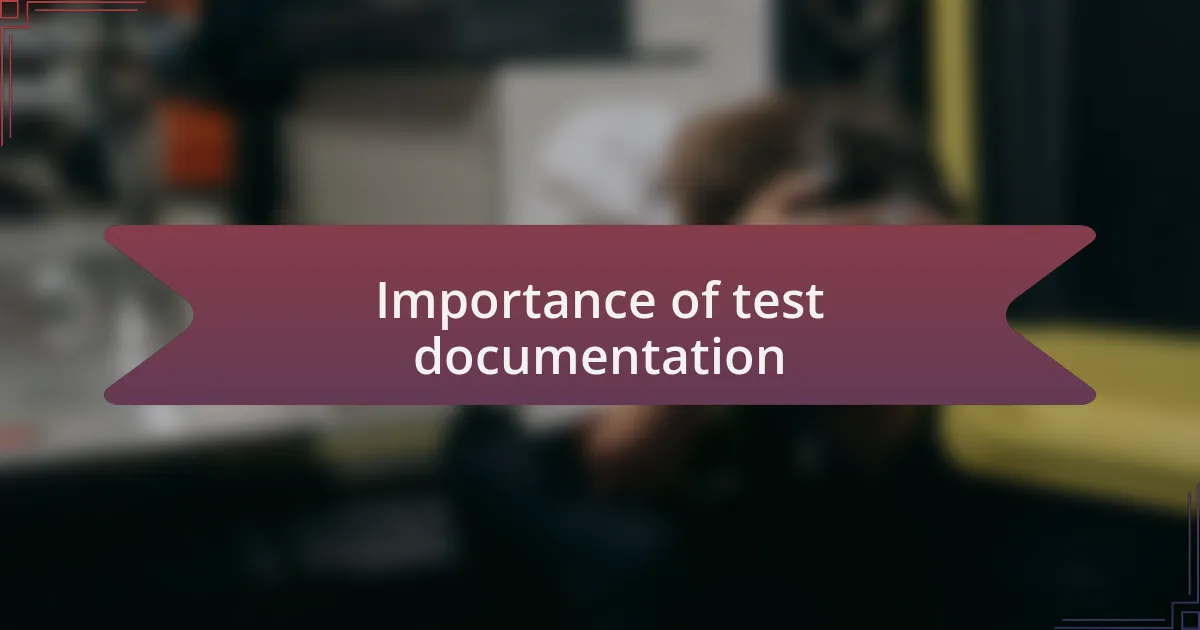
Importance of test documentation
Test documentation is not just a formality; it’s a lifeline for project consistency and quality. I recall a particular instance when a crucial bug slipped through our testing phase simply because we hadn’t documented our test cases properly. The panic that ensued when we had to scramble to identify the nature of the issue was intense. It reinforced for me that without rigorous documentation, teams risk missing critical insights that drive product success.
Furthermore, I’ve often observed that code quality improves when there’s a solid foundation of test documentation. One of my past teams implemented a collaborative review of our test plans, and it became a game changer. It fostered a sense of ownership and accountability among team members. How could we trust our code if we couldn’t clearly test it together? This process not only ensured that test coverage was comprehensive but also increased confidence in our releases.
Lastly, consider how documentation aids in onboarding new team members. I once mentored a fresh recruit who was tasked with understanding a complex testing framework. The well-structured documentation we had made it significantly easier for them to get up to speed. Without that clarity, the learning curve would have been daunting. It’s amazing how effective documentation can transform confusion into clarity, right?
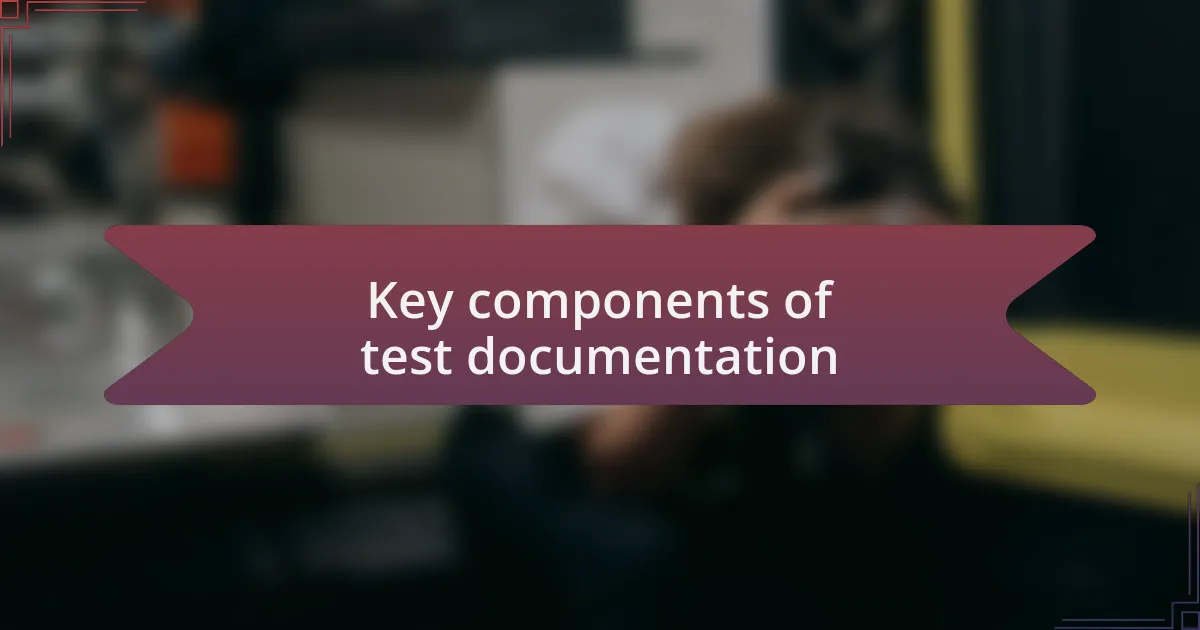
Key components of test documentation
When I think about the key components of test documentation, the test case is often the first thing that comes to mind. Each case outlines a specific scenario, detailing the input, expected outcome, and actual result. I once underestimated the clarity a well-written test case could provide until we faced a situation where miscommunication led to wasted hours addressing a bug that should have been easy to catch. It made me realize that a concise test case can serve as a common language for diverse team members.
Another vital element is the test plan, which acts as a roadmap for the testing process. I vividly remember a project where the absence of a clear test plan left us directionless, and we ended up duplicating efforts or, worse, missing out on crucial tests entirely. Having a structured plan not only ensures that every team member knows their roles but also enhances collaboration as everyone aligns towards common objectives. Isn’t it reassuring to have that level of clarity?
Lastly, we can’t forget about the defect log. Documenting defects meticulously helps maintain a historical record of issues and resolutions that can be invaluable for future testing cycles. After dealing with a particularly tricky bug last year, we referred back to our defect log and realized that understanding patterns can prevent the same mistakes from resurfacing. This log is a testament to learning from our past, allowing us to shape better testing approaches moving forward.
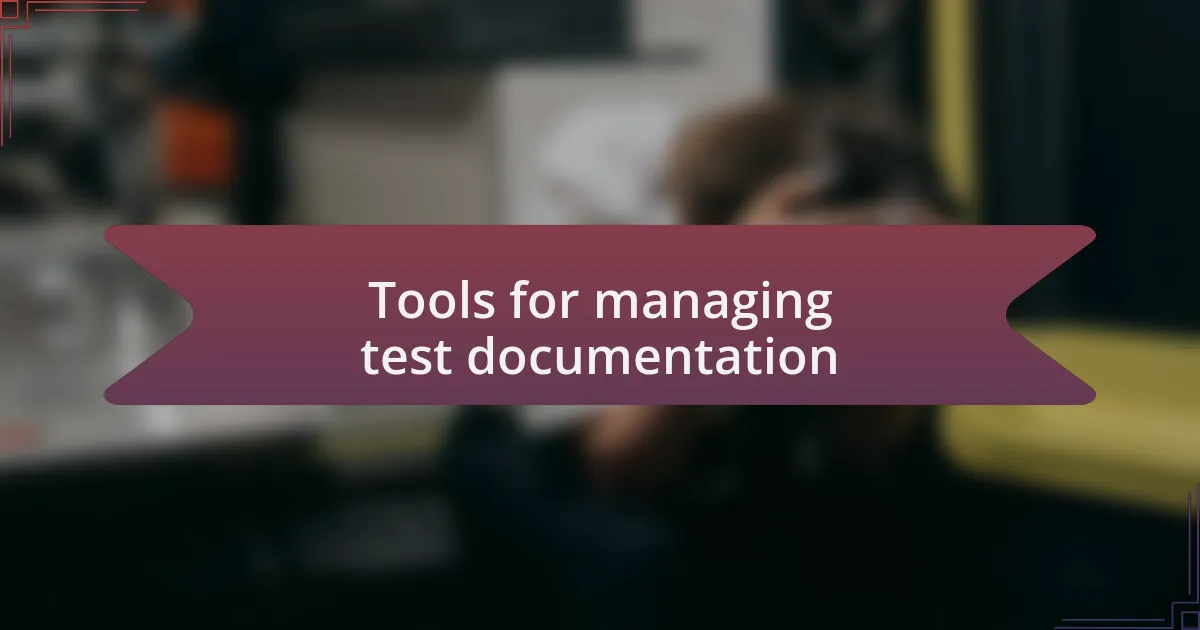
Tools for managing test documentation
When it comes to tools for managing test documentation, I’ve found that a good test management software can be a game changer. I remember my early days when we relied on spreadsheets. It was tedious and often led to confusion about the latest test case versions. Transitioning to a dedicated tool made all the difference—it offered clear organization, easy updates, and even collaboration features that let my team work simultaneously without stepping on each other’s toes. Have you ever felt the frustration of version control chaos? A reliable tool can eliminate that altogether.
Another category worth considering is automation tools that integrate with your test documentation. By employing a tool like Selenium or TestRail, I discovered how to save time on repetitive tasks and focus more on critical analyses. During one hectic release cycle, we automated our documentation process, and it allowed us to generate reports in real-time. Instead of manually compiling results, we could dedicate our energy to improving test quality. Doesn’t that sound like a dream?
Also, there’s the ever-important issue of collaboration, particularly in remote teams. I learned firsthand how tools like Confluence or Microsoft Teams can facilitate smoother communication among team members. I recall a project where misaligned expectations around test cases almost derailed us. But, by utilizing a shared platform, everyone stayed updated on changes. After all, doesn’t shared visibility foster accountability and trust within the team?
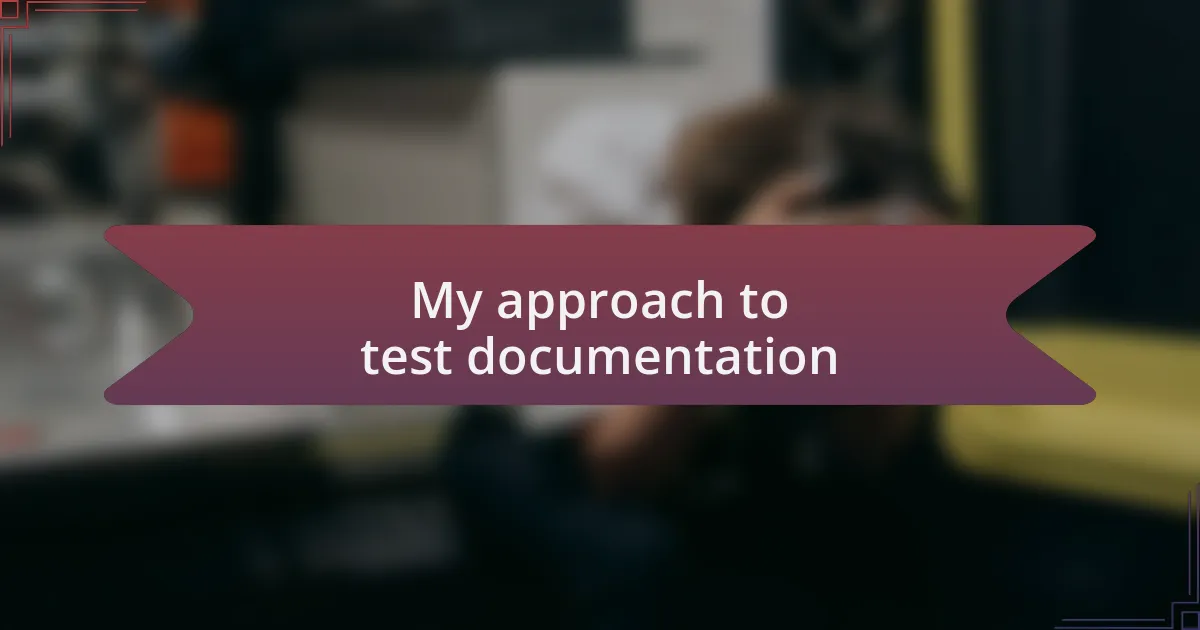
My approach to test documentation
When it comes to my approach to test documentation, I prioritize clarity and accessibility. I remember a project where I documented every test case meticulously, but when I reviewed the documents months later, they seemed like cryptic notes. It was then that I realized the importance of writing in a way that anyone, not just the testers, could understand. Have you ever glanced at a document and felt lost? Simplifying language and structuring content logically transformed my documents from bureaucratic artifacts into useful resources.
I also believe in the power of living documents. Instead of creating static records that gather dust, I like to keep my test documentation dynamic. During one particularly intense sprint, we established a practice where testers updated documents after each test run. This practice turned our documentation into a reflexive part of our process. Instead of asking, “What did we do last time?” we would just look back and find the answers immediately. Is there anything more satisfying than having the information you need at your fingertips?
Finally, embracing feedback is central to my approach. I encourage team members to share their thoughts on the documentation process. For example, after rolling out a new template for test cases, I invited input, and it led to significant improvements I hadn’t considered. How often do you feel like you have a voice in shaping the tools you use? Creating a culture around feedback not only enhances the documentation but also fosters a sense of ownership among the team.
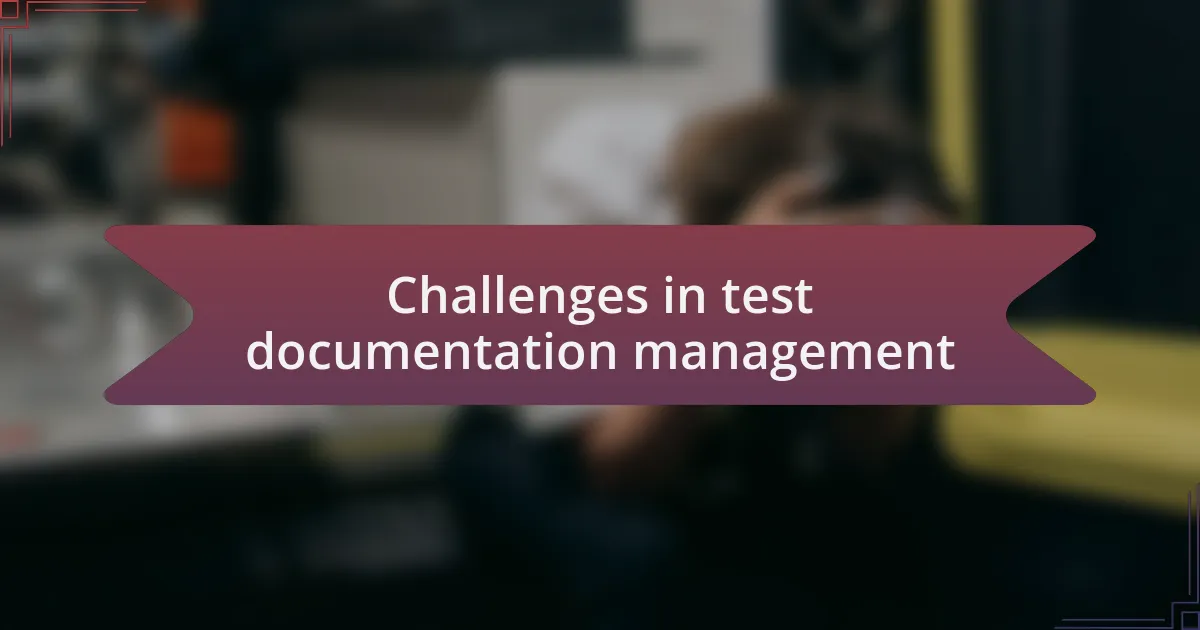
Challenges in test documentation management
Managing test documentation comes with its own set of challenges that can sometimes feel overwhelming. I recall a project where the sheer volume of test cases became a labyrinth. Each team member documented differently, which led to confusion. It made me wonder, do we really think about how our formats impact teamwork? This inconsistency often resulted in miscommunications and wasted time as we deciphered various styles instead of focusing on the actual tests.
Another hurdle I’ve faced is keeping the documentation relevant and up-to-date. I remember finishing a significant testing phase, only to find much of my documentation was outdated by the time we began the next iteration. It left me asking, how can we ensure that our documents evolve with the project? This experience reinforced the need for regular reviews and updates, as static documentation can lead to incorrect assumptions and ultimately impact product quality.
Lastly, I often struggle with the balance between detail and brevity. There’s a fine line—on one hand, we need comprehensive information, but on the other, excessive details can drown out important points. During a particularly tight deadline, I overcomplicated a test description, making it more confusing than helpful. Have you ever found yourself in a similar situation? Finding that sweet spot is vital for effective communication, and it requires constant adjustment and reflection on how best to document our processes.
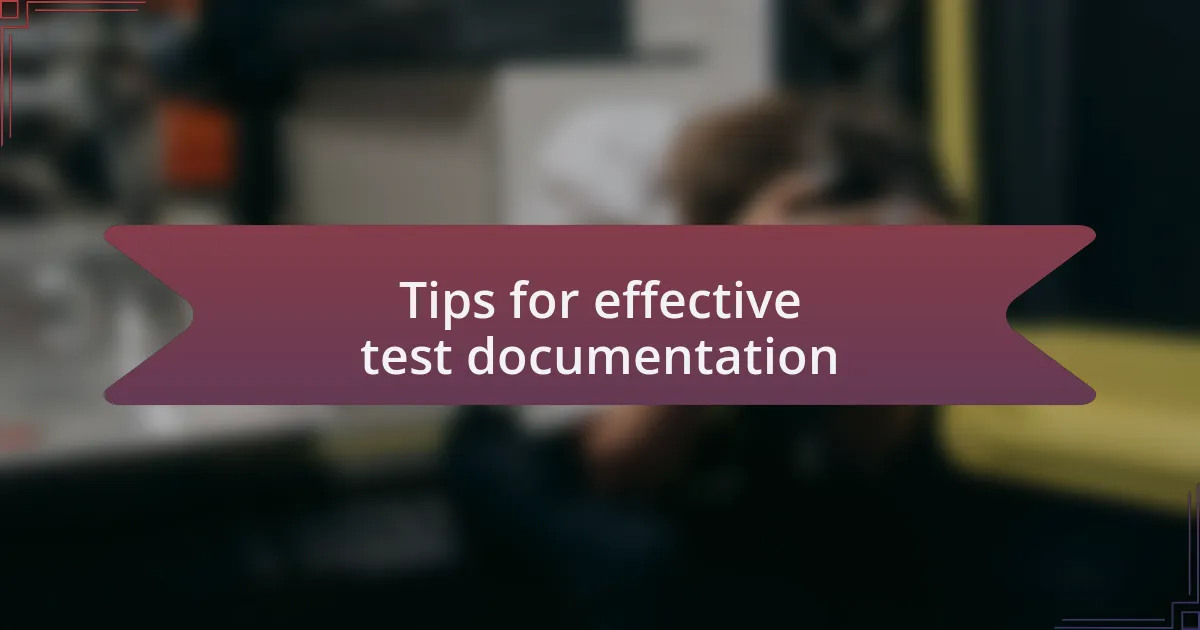
Tips for effective test documentation
When it comes to effective test documentation, clarity is paramount. Early in my career, I created a test document that was so dense with technical jargon that only a few team members could make sense of it. It made me realize: how can we expect diverse teams to succeed if they can’t understand the foundational documents? Using simple language and clear formatting transforms a daunting manual into a helpful guide, fostering better collaboration.
One of the best practices I’ve adopted is organizing test cases into logical categories, which directly mirrors the project’s functionality. I once tackled a project that was rife with confusion due to scattered test cases. By creating sections that aligned with user stories, I saw instant improvements during team discussions. Have you ever experienced the relief of finding exactly what you need in a well-structured document? That clarity not only saves time but also enhances our team’s confidence.
Additionally, incorporating regular feedback loops into the documentation process has been a game changer for me. I remember a project where we set aside time to review and revise test cases together. Not only did it keep the documentation accurate, but it also allowed team members to feel valued, as their insights shaped the final output. How often do we pause to listen to our peers? Creating a culture of open communication around documentation can transform it from a chore into a collaborative endeavor that everyone invests in.